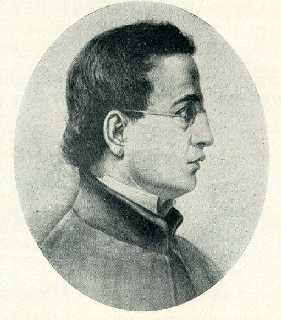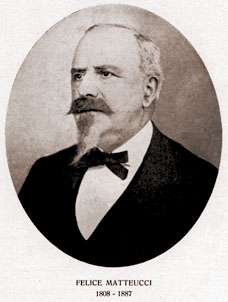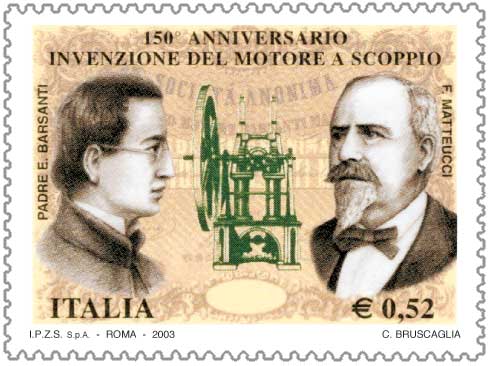<Back to Index>
- Engineer Eugenio Barsanti, 1821
- Engineer Felice Matteucci, 1808
PAGE SPONSOR

Father Eugenio Barsanti (12 October 1821 – 19 April 1864), also named Nicolò, was an Italian engineer, who invented a form of the internal combustion engine. It is not known whether he was the first to develop such an engine, as the patent request in question has been lost.
Barsanti was born in Pietrasanta, Tuscany. Lean and low of stature, he studied in a religious scientific oriented institute near Lucca, in Tuscany, and became a novitiate in Florence in 1838 of the Piarist Fathers or Scolopi, who were known for their opening to scientific study.
In 1841 Barsanti began teaching in the Collegio San Michele, situated in Volterra. Here, during a lecture describing the explosion of mixed Hydrogen and air, he realized the potential for using the energy of the expansion of combusting gases within a motor.
Subsequently, when teaching in a college level institute in Florence he met Felice Matteucci, an hydraulic engineer. Matteucci appreciated the idea for the engine, and the two men worked together on it for the rest of their lives.
They patented their invention in London, on 12 June 1854 as Italian law at that time could not guarantee sufficient international protection on the patent. The construction of the prototype was later completed in the 1860s.
The main advantage of the Barsanti - Matteucci engine was the use of the return force of the piston due to the cooling of the gas. Other approaches based on the pushing force of the explosion, like the one developed by France's Etienne Lenoir, were slower. The Barsanti - Matteucci engine was proven to be much more efficient, and won a silver medal from the institute of science of Lombardy.
In 1856 they developed a two - cylinder 5 HP motor and two years later they built a counter - working two - piston engine.
Barsanti thought that the new engine was a great improvement over the steam engine, it was much safer, less cumbersome and quick to operate. It was, however, not light enough for use as automotive engine. The main target was to provide mechanical energy in factories and for naval propulsion.
After some searching, Barsanti and Matteucci selected the John Cockerill foundry in Seraing, Belgium, to mass - produce a four HP engine. Orders for the engine soon followed from many countries within Europe.
Barsanti died suddenly at Seraing of typhoid fever, on 30 March 1864, and Matteucci alone was not able to lead the business. The development of the engine failed and Matteucci returned to his first occupation, hydraulics.
When Nikolaus Otto patented his engine, Matteucci unsuccessfully argued that he and his partner Barsanti were the originators.

Felice Matteucci (February 12, 1808 - September 13, 1887) was an Italian hydraulic engineer who co-invented an internal combustion engine with Eugenio Barsanti. It is not known whether they were the first to do so, as the patent in question was lost.
Born in Lucca, Matteucci studied hydraulic and mechanical engineering, first in Paris, then later in Florence. In 1851 he met Father Barsanti and appreciated his ideas for a new type of engine. They had a life - long collaboration developing the primary concept into a manufacturable item.
After the death of Barsanti in 1864, and following the failure of society in their time to promote the engine, he returned to his previous work as a hydraulic engineer. He studied new hydrometers (to measure the level of a river), rain gauges, and hydraulic operations over rivers.
In 1877 Matteucci argued that he and his partner Barsanti were the originators of the invention of the internal combustion engine. The patent registered by Nikolaus August Otto was very similar to the Barsanti - Matteucci design. This frustration contributed to the illness that eventually caused Matteucci's death, in his own home in Capannori, near Lucca in Tuscany.
